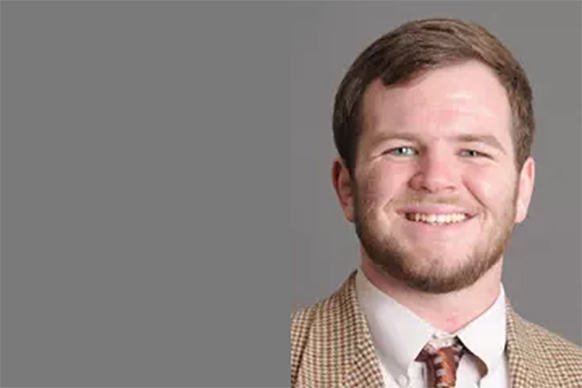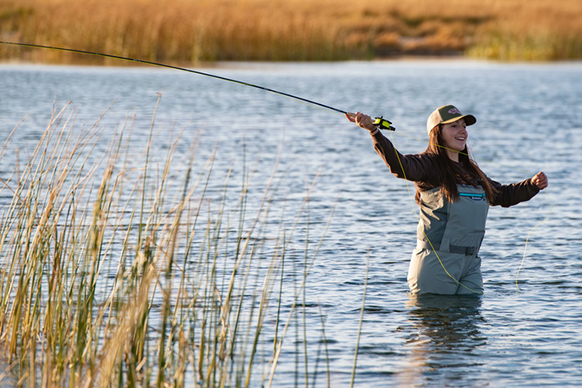What gets anglers hooked on fishing in the Snake River headwaters?
Published August 30, 2024
Master's thesis aims to understand the impact of changing climate to fishing tourism in northwestern Wyoming counties

Patrick Hofstedt
Which angling trip to the Snake River would you rather take: One that is cheaper than your last one, but you have to deal with wildfire smoke, or a more expensive one with no smoke and clear scenic views? Or would you rather stay at home, given these circumstances?
These are the kind of questions that Patrick Hofstedt asked anglers as part of his master’s thesis in agricultural and applied economics, analyzing “The preferences of anglers under alternative climate scenarios in northwestern Wyoming.”
Angling – fishing with a hook and a line – is an important contributor to Wyoming’s economy and a popular activity in Teton County around Jackson. In 2015, nearly 50 thousand fishing licenses were sold in the county, contributing to the over a billion dollars travelers spend in the county annually. Changes to angling across the Snake River with climate change over the coming decades therefore are of interest to the county and state as a whole.
Patrick Hofstedt earned his BA in Environmental Studies from Washington and Lee University in Virginia. He became interested in regenerative agriculture and the economics behind it. Although he claims to have applied to UW “on a whim,” he knew he wanted to experience the American West. Before he started the program in Laramie, he spent a season with the Forest Service at a popular fishing/rafting area in Idaho. This, coupled with previous experience in water sports, led to a shift in emphasis and becoming part of the WyACT project.
Gauging effects of different climate scenarios on fish and the environment
Patrick was able to draw on previous WyACT research. His survey was informed by the three climate scenarios that post-doc Anderson de Figueiredo has developed for the region and applied them to fish population and the environment.
The first scenario projects less snow and more heat days that will impact the stream temperatures in the summer peak angling season. Fish species that benefit from these conditions could outcompete the coveted Yellowstone cutthroat trout and other native fish.
The second scenario suggests that smoke from more frequent wildfires across the American West would worsen air quality and obscure the scenic views that attract visitors. The final scenario foresees the area becoming even more attractive to visitors who want to experience the Western United States, as other areas become unpleasantly hot. This increased tourism might put more stress on resources and lead to infrastructure changes.
With the aid of focus groups and individual anglers, Patrick created a survey that can help anticipate anglers’ reactions to these scenarios. The survey was then distributed by WYSAC, the Wyoming Survey & Analysis Center at the University of Wyoming, to buyers of fishing license purchasers in previous years Park, Teton, and Sublette County. Patrick reviewed over 330 replies from people who had fished in these counties over the past year. The typical respondent was from out of state, male and in his mid-50s and considered himself a slightly above average angler. Only one out of five anglers were on a guided trip.

Seeking solitude or easy access
Anglers are not a homogeneous crowd. Patrick discovered two groups: “On the basis of the survey results, I created two groups that I named ‘Nature Lovers’ and ‘Friendly Neighbors’ after their most salient characteristics.” Nature Lovers seek solitude and a natural experience, trying to avoid other anglers and wildfire smoke. The majority are residents of other states. The “Friendly Neighbors” tend to be Wyoming residents, and they value the ease of access to fishing spots. They are less bothered by other anglers.
Across both groups, wildfire smoke and lack of clear views were major deterrents. Seven percent of anglers would cancel their plans, leading to a loss of $6.5m in spending. A close second is easier access to angling spots that would result in more anglers. It came as a surprise that this would cause even more anglers to forego the trip than a change in fish species prevalence. Patrick: “If more tourists visit the area, and more infrastructure is built to accommodate them, it will become more likely that you have to share your spot with others.” And that is a no-go, especially for the Nature Lovers. They would rather deal with more difficult access to their fishing spots if that means fewer anglers. This is an important consideration for the planners in the area when thinking about adding infrastructure.
Nature lovers also place much more importance on Yellowstone cutthroat trout. Patrick: “Catching this popular native species is important to their experience, whereas for the friendly neighbors, whichever fish they caught was less important to them.” Overall, the Nature Lovers group is predicted to react stronger to any kind of change impacting their experience, opting out of a trip entirely to go somewhere else. Patrick: “They know what they want and are less likely to compromise.” In line with this attitude, they are also less likely to substitute a rafting trip as an alternative experience.
A summary of the thesis results is planned to be published in an Extension Bulletin and presented at events around Jackson.
A future in water topics
Patrick is hooked on watery themes: He is just starting his PhD in the Hydrologic Sciences program, and considers expanding his scope to other regions or water-based activities. His adviser Kristi Hansen points out: “As one of the first two social sciences students to be enrolled in the program, Patrick embodies the interdisciplinary approach that characterizes WyACT.” Patrick will continue to be part of WyACT for the reminder of the project.

